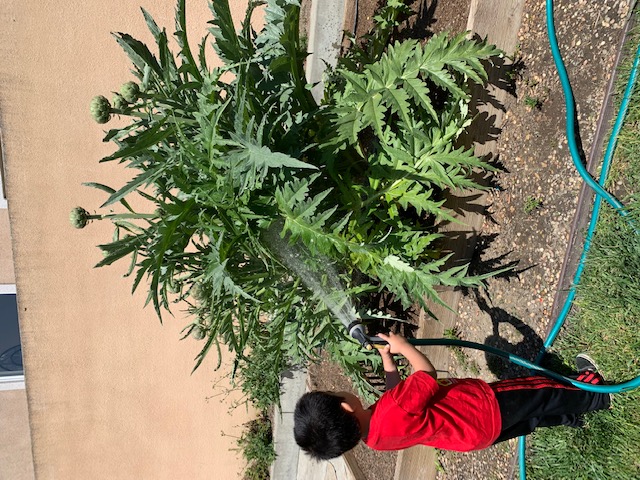
An advocate for outdoor learning, Dr. Montessori would say that with Spring right around the corner and Summer immediately following, there is no better time than now to open the outdoor classrooms and children’s gardens.
“There must be provision for the child to have contact with nature; to understand and appreciate the order, the harmony and the beauty in nature.” Maria Montessori
Children should have a place and ample time to learn about nature, or to simply enjoy their usual Montessori activities in an outdoor environment and be a part of the children’s garden each and every day.
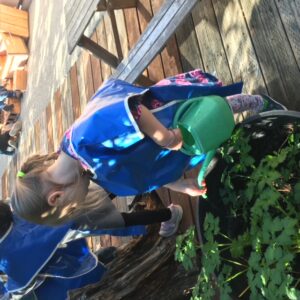
Outdoor Community
Whenever I meet an adult/young adult who lets me know they too were a Montessori child, I ask them to reflect on their earliest memories attending a Montessori preschool. “Tell me something you remember about the Montessori classroom.” It is not surprising that many come up with sensory experiences of nature, such as pulling a large carrot from the soil, scrubbing a seashell, watering a plant or discovering worms. Rarely do I hear, “we had these really fun worksheet packets that we colored”.
Just a few things that might be found in the MSOSV outdoor classroom environments.
In the spring, summer and fall, families can look forward to fresh fruit, vegetables and herbs being harvested and then sent home. The children harvest basil to make pesto, pick peaches to make a delicious peach parfait and many children just pop cherry tomatoes into their mouths right from the vine. The children are the Masters of the garden.
Together they plan, work, sow and enjoy the garden and outdoor environment.
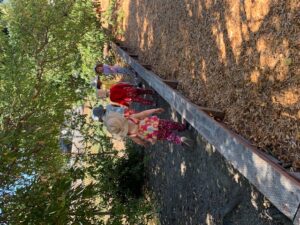
Peach Tree Stroll
Instead of forcing children to learn through an overly structured environment, a Montessori classroom emphasizes free exploration, and an outdoor classroom offers even more free exploration than an indoor class. Children can choose their own activities and work in different areas.
The free exploration gives a child a chance to find their strengths and interests, which will allow them to branch out and build on various skills.
This free exploration also provides child multiple opportunities to expand on their social skills. Children will interact with other children and learn how to problem solve.
Despite the changes caused by the Covid-19 pandemic, there is still plenty of fun to be had working outdoors. Breathing in fresh air can give children more focus and energy to complete tasks. The natural light from the sun will put children in a better mood and also helps increase levels of vitamin D.
Children are able to spread out and are less likely to spread germs. There is more physical space in our outdoor settings, larger and more open than the indoor classroom.
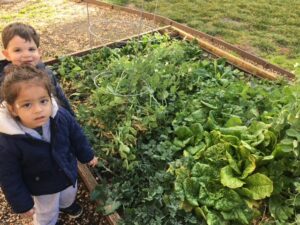
Vegetable and Herb Garden
Many parents are surprised to learn that STEM education does a lot more than they think. In fact, it can boost science literacy, create children who think critically, and enable an entire generation to be more than workers but to be innovators. Innovation is a necessary part of a continually growing economy. It’s clear from stats and observation that most future jobs will require at least a basic understanding of science and math.
Children develop diverse skill sets and a passion for exploration and growth. We don’t need children to memorize random facts anymore. We have so many facts at our fingertips. Gone are the days where we go to the library to “look it up”.
Sensorial, Language and Math Ideas
The outdoor classroom is full of exciting ways to open and refine all 5 senses.
Children can explore different textures such as the rough pavement compared to the smoothness of a leaf. Draw shapes with different colors of chalk. Compare the colors of the grass, sky, flowers, etc.
Children use chalk on the sidewalk to write letters, draw flowers and more. They set up a Peace area to sit outside while reading books selected for the garden. The children have snack or just might be found listening to the sounds of the outdoors.
All activities are open-ended allowing the children to discover, question and think for themselves.
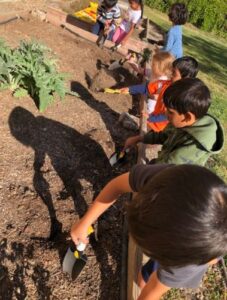
Planting Artichoke
There are many outdoor practical-life activities such as simple gardening like digging in soil and planting seeds. Children try their hand at raking, sweeping, or practice their pouring skills with water or sand.
The traditional classroom experience includes indoor learning, but the addition to our outdoor classroom expands beyond the typical outdoor time found during “outside playtime”. True classroom time is dedicated to the outdoors, and children gain a lot of knowledge from the time they spend outdoors.
The foundation of gardening also includes a lot of independent skills children learn and use as they grow older.
https://www.communityplaythings.com/resources/articles/2017/Outdoor-Learning
https://littlebinsforlittlehands.com/outdoor-science-activities-kids/
https://www.naeyc.org/resources/topics/stem
https://www.canr.msu.edu/news/gardening_with_young_children_helps_their_development